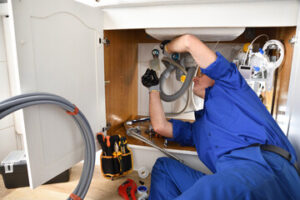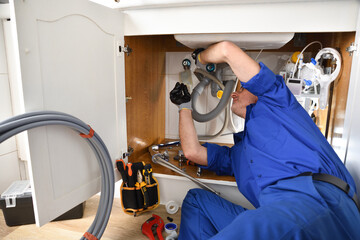West Chester Drain Cleaning involves removing obstructions from a drain or sewer line. Whether it’s hair, soap scum, food residue, or mineral buildup, these obstructions can restrict the flow of water and lead to severe problems over time.
Fortunately, there are many effective solutions for keeping your drains clear and clog-free. Here are a few of the most popular ones:
If you’ve ever noticed a foul smell coming from your drains, it’s not only embarrassing, but it may also indicate a serious issue with your plumbing. It’s important to contact a professional as soon as possible so they can clean your drain and fix any problems that may be causing it.
Smelly drains are often caused by the build-up of food particles and other organic material that can cause clogs, unpleasant odors, and slow drainage. While you can use household products to get rid of the odor, it’s best to have your drain professionally cleaned to ensure that it’s completely clean and free from debris.
One of the most common causes of stinky drains is the presence of hydrogen sulfide, which is a gas that is released when bacteria breaks down organic material. The smell is similar to rotten eggs, and it can be very unpleasant for homeowners. The good news is that hydrogen sulfide is not a health risk, and it can be easily treated with vinegar and baking soda.
To remove the odor, pour half a cup of baking soda down the drain, followed by half a cup of vinegar. Wait a few minutes to allow the mixture to work, then flush the drain with hot water. Repeat as needed to eliminate bad odors and prevent clogs.
If you have a small clog, try using a plunger to dislodge the blockage. You can also try pouring boiling water down the drain to help loosen and flush out any remaining organic materials. Finally, you can try pouring a cup of bleach down the drain to disinfect and deodorize the area.
Keep in mind that harsh chemical drain cleaners are usually not recommended, as they can damage your pipes and cause further problems down the line. Using home remedies to eliminate drain odors is typically sufficient, but when the problem is more severe, it’s best to call a professional like Reimer, who can provide fast and effective drain cleaning services that will leave your sinks, tubs, and showers fresh and clean.
Clogged Drains
A clogged drain can lead to a number of plumbing issues including water damage and foul smells. In many cases, the best way to handle these issues is to call a professional plumber for drain cleaning services. However, there are some things you can do to help prevent serious clogs in the first place.
Hair is one of the leading causes of clogged drains, especially in the shower and toilet. Although it may seem harmless, this debris can cause significant blockages in your drains if it builds up over time. Fortunately, you can reduce the chances of this happening by regularly clearing away any hair that falls down your drains. There are also a number of devices and inexpensive chemicals that you can use to break up hair buildup in your drains.
Another common cause of clogged drains is soap residue. Over time, this can build up and create a thick clog that is difficult to remove. To help prevent this, you should make sure to rinse off all of the soap residue after washing dishes or taking a shower. You can also try pouring baking soda and vinegar down your drains once a month to help break down any residue that might be building up in the pipes.
Cooking grease and oils are also a common cause of clogged drains, particularly in kitchen sinks. These substances can solidify in your drain pipes and build up with other food scraps over time, creating a major clog that will require professional attention to repair. To avoid this problem, you should always dispose of cooking grease and oils in an approved waste container instead of simply throwing them down the drain.
Other common reasons for blocked drains include a buildup of foreign objects, such as toys, sanitary items, or electronic waste. These objects can block your drains when they get caught in the wrong part of the pipe. It’s a good idea to put strainers over your drains to catch any objects that might fall down them. Keeping nearby trees well-maintained and trimmed will also help prevent them from growing into your pipes and causing blockages.
Clogged Toilets
Clogged toilets can be a major headache and can often mean that other drains in the home are also impacted. If you are constantly dealing with a clogged toilet it might be time to call for professional drain cleaning services.
One of the most common causes of constant toilet clogs is non-flushable items like Q-tips, cotton balls, and other hygiene products. These types of non-flushable items are a big problem in households with young children who love to place toys and other objects into the toilet. This type of clog is easily preventable by reminding family members that only toilet paper, human waste and water should be flushed down the commode. Keeping garbage cans available in all bathrooms is a great way to ensure that foreign objects are properly disposed of.
Another frequent cause of a clogged toilet is hair. While it may seem harmless, hair can actually create serious blockages that are hard to remove without the help of a professional. If you find that your toilet is consistently clogged and plunging does not work, a drain snake (also known as an auger) can be used to break up and remove the clog.
If your toilet clogs regularly and you have multiple drains in the home that are impacted, it could be a sign of an external issue with your sewer lines or pipework. If your pipes are made of clay or cast iron, the lining can deteriorate over time and allow for water and waste to flow into the sewage system, which can then lead to clogs in other parts of the house. In this case, it is best to have a professional evaluate the situation and install an epoxy lining system designed specifically for iron pipes.
Sometimes the issue is simply that there is a blockage in the s-trap, which is located between the toilet bowl and the drainage line. Plunging the commode can usually clear this, but if it is persistent you should try using a drain snake or a chemical cleaner. If you try using a chemical and it doesn’t work, pouring hot water into the toilet can help dislodge the clog.
Clogged Showers
Nothing is more frustrating than a clogged shower. The smell of sewage, the puddles that pool on your floor and the inability to use your shower are all clear warning signs that you need to address a blocked drain before it gets worse. Fortunately, there are some simple DIY methods that can help you get your shower drain back up and running in no time at all.
Hair is a major cause of clogged showers. Everyone sheds a few strands of hair while bathing, and while this is perfectly normal, stray strands can easily wrap around other grime like dirt and soap to form clogs. In addition, hard water contains insoluble minerals that can slowly build up over time to block your pipes.
One of the easiest ways to prevent a clogged shower is to set up a regular maintenance routine. Place a hair catcher on the drain to catch any stray strands of hair before they wash away, and clean out your shower drain grate regularly by removing it and brushing away any accumulated grime. Using a special chemical drain cleaner or auger to cut through any built-up grease and soap scum once a month can also reduce the risk of a clog.
If the clog is too severe for any of these DIY methods to fix, it might be time to call in a professional plumber. Getting to grips with how to treat and avoid clogged shower drains is an essential plumbing skill that every homeowner should master.
Clogged showers can be dangerous if not dealt with promptly, and they can lead to sewage backups that threaten your health and the integrity of your home’s plumbing. Addressing them sooner rather than later will save you money and prevent the need for more expensive professional repairs in the future.



